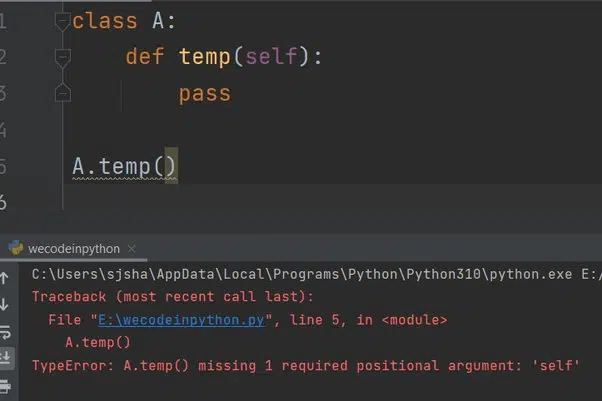Do you want to learn how to fix the “TypeError: missing 1 required positional argument: ‘self’” and how to troubleshoot it 🤔?
In Python, classes are essential to object-oriented programming (OOP). Classes allow you to define objects with data and behavior, enabling you to organize and structure your code more efficiently. However, when working with classes in Python, it is common to encounter an error message that reads “TypeError: missing 1 required positional argument: ‘self'”.

This article will explain why and how to overcome the “TypeError: missing 1 required positional argument: ‘self'” error occurs. Therefore, let’s explore the subject and look at various solutions without further ado! 👇
Table of Contents
What is ‘self’ in Python?
In Python, ‘self’ is a reference to the instance of a class. When we create an instance of a class, we can use the ‘self’ keyword to refer to that instance within the class definition. By using ‘self’, we can access the attributes and methods of the instance, as well as modify them.
The ‘self’ parameter is always the first parameter in a function definition in Python. It is a convention to name this parameter ‘self’, but you can technically name it whatever you like, as long as it is the first parameter in the function definition. When you call a function on an instance of a class, Python automatically passes a reference to that instance as the first argument to the function. This is why we need to include ‘self’ as the first parameter in our function definition – so that we can access the instance within the method.
Why is Self Important?
Self is important because it allows us to access the attributes and methods of an object from within the object itself. For example, when we define a function in a class, we can use the self variable to refer to the instance of the class that the method is being called on. This allows us to access the attributes and functions of the instance.
For example, let’s say we have a class called BankAccount, which has attributes for the account balance and the account owner’s name and functions for depositing and withdrawing money from the account. Here’s what the code might look like:
How Does the “TypeError: Missing 1 Required Positional Argument: ‘self’” Error Occur?
This error message is usually encountered when trying to call a function on an object without properly instantiating the object. In Python, methods defined inside a class always take the instance of the class as their first argument. The parameter ‘self denotes this.’ When calling a function on an object, the object instance is passed as the ‘self‘ parameter, allowing the function to access the object’s data and behavior.
Consider the following code:
Code
class Result:
def __init__(self, marks):
self.marks = marks
def status(self):
print(f"Result: {self.marks}")
Result.status()
Output

In the above example, the error missing 1 required positional argument: ‘self’ occurs. Because you didn’t instantiate an object of the Result class, the self variable is not passed to the status() function.
How to Fix the “TypeError: Missing 1 Required Positional Argument: ‘self’” Error?
To fix the “TypeError: missing 1 required positional argument: ‘self'” error, you need to instantiate an object from the class first. This is done by adding parentheses next to the class name. See the example below:
Code
class Result:
def __init__(self, marks):
self.marks = marks
def status(self):
print(f"Result: {self.marks}")
Result("Final").status()
Output
Result: Final
The self variable is given when you call the status() function from the instantiated object.
By the way, this is a type of error that occurs when essential positional arguments are absent. That’s how you fix the error of missing one mandatory positional argument:’self.‘
Conclusion
In conclusion, the “TypeError: missing 1 required positional argument: ‘self'” error is standard when working with classes in Python. It is caused by forgetting to include the ‘self‘ parameter in the function definition or trying to access a class attribute using an instance name instead of a class name.
To fix this error, you must include the ‘self‘ parameter in the function definition and use the class name to access class attributes. By understanding how ‘self‘ works in Python and using it correctly, you can avoid this error and write more efficient and organized code.
If you’ve found this article helpful, remember to share it.











